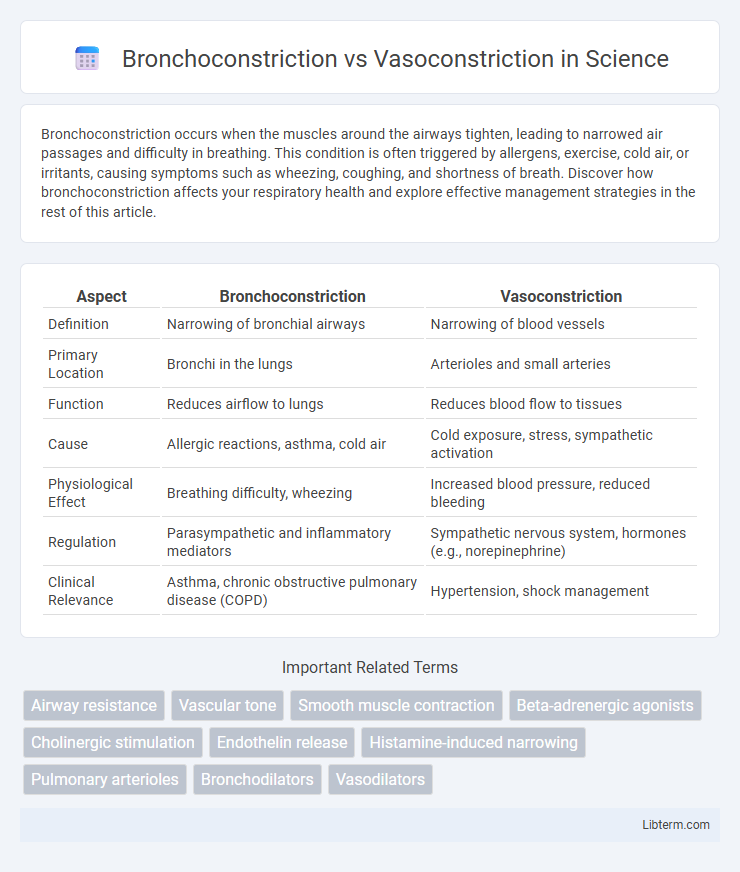Bronchoconstriction occurs when the muscles around the airways tighten, leading to narrowed air passages and difficulty in breathing. This condition is often triggered by allergens, exercise, cold air, or irritants, causing symptoms such as wheezing, coughing, and shortness of breath. Discover how bronchoconstriction affects your respiratory health and explore effective management strategies in the rest of this article.
Table of Comparison
| Aspect | Bronchoconstriction | Vasoconstriction |
|---|---|---|
| Definition | Narrowing of bronchial airways | Narrowing of blood vessels |
| Primary Location | Bronchi in the lungs | Arterioles and small arteries |
| Function | Reduces airflow to lungs | Reduces blood flow to tissues |
| Cause | Allergic reactions, asthma, cold air | Cold exposure, stress, sympathetic activation |
| Physiological Effect | Breathing difficulty, wheezing | Increased blood pressure, reduced bleeding |
| Regulation | Parasympathetic and inflammatory mediators | Sympathetic nervous system, hormones (e.g., norepinephrine) |
| Clinical Relevance | Asthma, chronic obstructive pulmonary disease (COPD) | Hypertension, shock management |
Introduction to Bronchoconstriction and Vasoconstriction
Bronchoconstriction refers to the narrowing of the airways in the lungs due to the tightening of surrounding smooth muscle, significantly impacting respiratory airflow and oxygen exchange. Vasoconstriction involves the constriction of blood vessels caused by the contraction of muscular walls within the vessels, leading to increased blood pressure and reduced blood flow to specific areas. Both processes are critical physiological responses regulated by the autonomic nervous system to maintain homeostasis and react to environmental stimuli.
Defining Bronchoconstriction: Mechanisms and Effects
Bronchoconstriction involves the narrowing of the airways due to the contraction of smooth muscle in the bronchial walls, primarily triggered by allergens, irritants, or parasympathetic nervous system activation. This process leads to reduced airflow, causing symptoms such as wheezing, shortness of breath, and coughing, commonly observed in asthma and chronic obstructive pulmonary disease (COPD). Unlike vasoconstriction, which affects blood vessel diameter and blood flow, bronchoconstriction specifically impairs respiratory function by limiting air passage in the lungs.
Understanding Vasoconstriction: Processes and Impact
Vasoconstriction is the narrowing of blood vessels caused by the contraction of vascular smooth muscle, primarily in the arterial walls, which decreases blood flow and increases blood pressure. This process is regulated by factors such as the autonomic nervous system, hormones like norepinephrine and angiotensin II, and local chemical signals including endothelin. Vasoconstriction plays a crucial role in thermoregulation, blood pressure maintenance, and the redistribution of blood during stress or injury, contrasting with bronchoconstriction, which affects airway diameter and respiratory function.
Key Differences Between Bronchoconstriction and Vasoconstriction
Bronchoconstriction refers to the narrowing of the airways in the lungs due to contraction of surrounding smooth muscle, primarily affecting airflow and respiratory function. Vasoconstriction involves the narrowing of blood vessels caused by contraction of vascular smooth muscle, which regulates blood pressure and blood flow to various organs. Key differences include their target tissues--bronchial smooth muscle versus vascular smooth muscle--and their physiological roles in respiratory versus cardiovascular systems.
Causes and Triggers: Bronchoconstriction vs Vasoconstriction
Bronchoconstriction is primarily triggered by allergens, cold air, exercise, and irritants such as smoke, causing the smooth muscles in the airways to tighten and narrow the bronchi. Vasoconstriction is induced by cold exposure, stress, nicotine, and certain hormones like norepinephrine, leading to the narrowing of blood vessels and reduced blood flow. While bronchoconstriction mainly affects respiratory function, vasoconstriction influences circulation and blood pressure regulation.
Symptoms: How Bronchoconstriction and Vasoconstriction Manifest
Bronchoconstriction primarily manifests through symptoms like wheezing, shortness of breath, coughing, and chest tightness due to the narrowing of the airways. Vasoconstriction results in symptoms such as cold extremities, pale skin, headaches, and high blood pressure because of the narrowing of blood vessels. Both conditions involve restricted flow--air in bronchoconstriction and blood in vasoconstriction--leading to their distinct clinical presentations.
Health Conditions Linked to Bronchoconstriction
Bronchoconstriction involves the narrowing of the airways due to tightening of bronchial muscles, commonly triggering respiratory conditions such as asthma, chronic bronchitis, and allergic reactions. These health issues can cause symptoms like wheezing, shortness of breath, and coughing, often exacerbated by allergens, irritants, or infections. Unlike vasoconstriction, which affects blood vessels and influences blood pressure and circulation, bronchoconstriction directly impairs airflow and gas exchange in the lungs, highlighting its critical role in pulmonary health disorders.
Diseases and Disorders Associated with Vasoconstriction
Vasoconstriction plays a critical role in disorders such as hypertension, where excessive narrowing of blood vessels increases blood pressure and strains the cardiovascular system. Chronic vasoconstriction is implicated in peripheral artery disease, leading to reduced blood flow and tissue ischemia. Conditions like Raynaud's phenomenon involve episodic vasoconstriction of extremities, causing pain and discoloration due to impaired circulation.
Diagnosis and Monitoring of Both Conditions
Diagnosis of bronchoconstriction primarily involves spirometry and peak flow measurements to assess airway obstruction, while vasoconstriction is evaluated through blood pressure monitoring and Doppler ultrasound to measure vascular resistance. Continuous monitoring of bronchoconstriction uses devices like portable peak flow meters and exhaled nitric oxide analyzers, whereas vasoconstriction is tracked using ambulatory blood pressure monitors and pulse wave velocity assessments. Biomarkers such as inflammatory mediators in asthma and endothelial function markers in vascular disease aid in differentiating these conditions and guiding treatment efficacy.
Treatment Approaches: Bronchoconstriction vs Vasoconstriction
Treatment approaches for bronchoconstriction primarily involve bronchodilators such as beta-2 agonists (e.g., albuterol) and anticholinergics to relax airway smooth muscle and improve airflow. Vasoconstriction management focuses on medications like alpha-adrenergic agonists (e.g., phenylephrine) and calcium channel blockers to regulate blood vessel diameter and control blood pressure. Understanding the distinct pathophysiology of airway smooth muscle contraction versus vascular smooth muscle constriction guides targeted pharmacological interventions.
Bronchoconstriction Infographic

 libterm.com
libterm.com